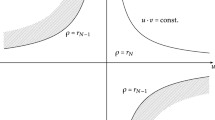Abstract
The space of light rays \({\mathcal {N}}\) of a conformal Lorentz manifold \((M,{\mathcal {C}})\) is, under some topological conditions, a manifold whose basic elements are unparametrized null geodesics. This manifold \({\mathcal {N}}\), strongly inspired on R. Penrose’s twistor theory, keeps all information of M and it could be used as a space complementing the spacetime model. In the present review, the geometry and related structures of \({\mathcal {N}}\), such as the space of skies \(\varSigma \) and the contact structure \({\mathcal {H}}\), are introduced. The causal structure of M is characterized as part of the geometry of \({\mathcal {N}}\). A new causal boundary for spacetimes M prompted by R. Low, the L-boundary, is constructed in the case of 3–dimensional manifolds M and proposed as a model of its construction for general dimension. Its definition only depends on the geometry of \({\mathcal {N}}\) and not on the geometry of the spacetime M. The properties satisfied by the L–boundary \(\partial M\) permit to characterize the obtained extension \({\overline{M}}=M\cup \partial M\) and this characterization is also proposed for general dimension.















Similar content being viewed by others
Data availability
Data sharing is not applicable to this article as no new data were created or analyzed in this study.
Change history
08 September 2022
A Correction to this paper has been published: https://doi.org/10.1007/s10714-022-02992-7
Notes
The expression of the equation of Jacobi fields depends on the sign of definition of the Riemann curvature tensor \({\mathbf {R}}\) and on the order of the arguments. So,
$$\begin{aligned} J'' - {\mathbf {R}}\left( J,\gamma '\right) \gamma ' = 0, J'' + {\mathbf {R}}\left( \gamma ',J\right) \gamma ' = 0, J'' - {\mathbf {R}}\left( \gamma ',J\right) \gamma ' = 0 \end{aligned}$$are other expressions we can find in the literature.
This is not an automatic property for any \({\mathcal {U}}\in {\mathcal {N}}\) and \(\overline{{\mathcal {U}}}\in \overline{{\mathcal {N}}}\). If \(U=\varSigma ({\mathcal {V}}) \) and \({\overline{U}}=\varSigma (\overline{{\mathcal {U}}})\) such that \(\varPhi \left( U\right) \subset {\overline{U}}\), then we can choose \({\mathcal {U}}=\phi ^{-1}\left( \phi \left( {\mathcal {V}}\right) \cap \overline{{\mathcal {U}}}\right) \subset {\mathcal {V}}\). Now, if \(X\subset {\mathcal {V}}\), since \(\varPhi \left( U\right) \subset {\overline{U}}\) then \(\phi \left( X\right) \subset \phi \left( {\mathcal {V}}\right) \cap \overline{{\mathcal {U}}}\) and since \(\phi \) is a diffeomorphism, then \(X\in {\mathcal {U}}\). So we have \(U=\varSigma \left( {\mathcal {U}}\right) = \varSigma \left( {\mathcal {V}}\right) \) and \(\phi \left( {\mathcal {U}}\right) \subset \overline{{\mathcal {U}}}\).
This can be shown if we notice that, since U is globally hyperbolic, by [51, Thm. 3.78], there exists a diffeomorphism \(h:C\times \mathbb {R}\rightarrow U\) such that \(C_{\lambda }=h\left( C\times \{\lambda \}\right) \) is a smooth spacelike Cauchy surface in U. Without any lack of generality, we can assume that \(C=C_0\) and \(C_{-}=C_c\) for some \(c\in \mathbb {R}\). Observe that any light ray can be parametrized by \(\gamma (s)=\mathrm {exp}_{\gamma (0)}\left( s\cdot \gamma '(0)\right) \) then, if \(p_2:C\times \mathbb {R}\rightarrow \mathbb {R}\) is the canonical projection, then the equation \(p_2 \circ h^{-1}\left( \gamma (s)\right) =c\) can be written in coordinates by an equation such that \(F(x,y,\theta ,s)=c\). Then, the existence of \(s_{\gamma }=s_{\gamma }(x,y,\theta )\) follows from the Theorem of implicit function.
References
Aké, L., Flores, J.L., Sánchez, M.: Structure of globally hyperbolic spacetimes with timelike boundary. Rev. Mat. Iberoam. 37, 45–94 (2021). https://doi.org/10.4171/rmi/1201
Abraham, R., Marsden, J.E., Ratiu, T.: Manifolds, tensor analysis and applications. Springer Verlag, New York (1988)
Arnold, V.I.: Mathematical methods of classical mechanics. Springer Verlag, New York (1989)
Bautista, A., Ibort, A., Lafuente, J.: On the space of light rays of a spacetime and a reconstruction theorem by Low. Class. Quantum Grav. 31, 075020 (2014)
Bautista, A., Ibort, A., Lafuente, J.: Causality and skies: is refocussing necessary? Class. Quantum Grav. 32, 105002 (2015)
Bautista, A., Ibort, A., Lafuente, J.: The canonical contact structure in the space of light rays. A Mathematical Tribute to Professor José María Montesinos Amilibia. Dpto. Geometría y Topología, UCM, Madrid. (2015)
Bautista, A., Ibort, A., Lafuente, J., Low, R.: A conformal boundary for space-times based on light-like geodesics: The \(3\)-dimensional case. J. Math. Phys. 58, 022503 (2017)
Bautista, A., Ibort, A., Lafuente, J.: L-extensions and L-boundary of conformal space-times. Gen. Relativ. Gravit. 50, 153 (2018). https://doi.org/10.1007/s10714-018-2479-9
Beem, J.K., Ehrlich, P.E., Easley, K.L.: Global Lorentzian Geometry. Marcel Dekker, New York (1996)
Bernal, A.N., Sánchez, M.: On smooth Cauchy hypersurfaces and Geroch’s splitting theorem. Commun. Math. Phys. 243, 461–470 (2003)
Brickell, F., Clark, R.S.: Differentiable manifolds. An Introduction. Van Nostrand Reinhold, London (1970)
Budic, R., Sachs, R.K.: Causal boundaries for general relativistic spacetimes. J. Math. Phys. 15, 1302–1309 (1974)
Cannas da Silva, A.: Lectures on symplectic geometry. Springer-Verlag, New York (2001)
Ciaglia, F.M., Di Cosmo, F., Ibort, A., Marmo, G., Schiavone, L., Zampini, A.: Causality in Schwinger’s picture of quantum mechanics. Entropy 24, 75 (2022). https://doi.org/10.3390/e24010075
Chernov, V., Rudyak, Y.: Linking and causality in globally hyperbolic space-times. Comm. Math. Phys. 279, 309–354 (2008)
Chernov, V., Nemirovski, S.: Legendrian links, causality, and the Low conjecture. Geom. Funct. Analysis 19, 1320–1333 (2010)
Chernov, V., Nemirovski, S.: Non-negative Legendrian isotopy in \(ST^{*}M\). Geom. Topol. 14, 611–626 (2010)
Chernov, V., Nemirovski, S.: Universal orderability of Legendrian isotopy classes. J. Symplectic Geom. 14(1), 149–170 (2016)
Chernov, V., Nemirovski, S.: Redshift and contact forms. J. Geom. Phys. 123, 379–384 (2018)
Chernov, V.: Conjectures on the relations of linking and causality in causally simple spacetimes. Class. Quantum Grav. 35, 105010 (2018)
Chernov, V.: Causality and Legendrian linking for higher dimensional spacetimes. J. Geom. Phys. 133, 26–29 (2018)
Field, T.R., Low, R.: Causal relations via linking in twistor space. J. Geom. Phys. 28, 339–348 (1998)
Flores, J.L., Herrera, J., Sánchez, M.: On the final definition of the causal boundary and its relation with the conformal boundary. Adv. Theor. Math. Phys. 15(4), 991–1057 (2011)
García-Parrado, A., Senovilla, J.M.M.: Causal structures and causal boundaries. Class. Quantum Grav. 22, R1–R84 (2005)
Geiges, H.: An introduction to contact topology. Cambridge University Press (2008)
Geroch, R.P.: Local characterization of singularities in general relativity. J. Math. Phys. 9, 450–465 (1968)
Geroch, R.P., Kronheimer, E.H., Penrose, R.: Ideal points in Space-Time. Proc. Roy. Soc. London. A 327, 545–567 (1968)
Guillemin, V.: Cosmology in \((2+1)\)-dimensions, cyclic models, and deformations of \(M_{2,1}\). (AM–121). Princeton University Press, (1989)
Harris, S.G.: Universality of the future chronological boundary. J. Math. Phys. 39(10), 5427–5445 (1998)
Harris, S.G.: Topology of the future chronological boundary: universality for spacelike boundaries. Class. Quantum Grav. 17(3), 551–603 (2000)
Hartman, P.: Ordinary differential equations. Wiley, New York (1964)
Hawking, S.W., Ellis, G.F.R.: The large scale structure of space-time. Cambridge University Press, Cambridge (1973)
Hedicke, J., Minguzzi, E., Schinnerl, B., Steinbauer, R., Suhr, S.: Causal simplicity and (maximal) null pseudoconvexity. Class. Quantum Grav. 38, 227002 (2021)
Khesin, B., Tabachnikov, S.: Pseudo-Riemannian geodesics and billiards. Adv. Math. 221, 1364–1396 (2009)
Kinlaw, P.A.: Refocusing of light rays in space-time. J. Math. Phys. 52, 052505 (2011)
Kulkarni, R.S.: Conformal structures and Möbius structures. Conformal geometry (R.S. Kulkarni & U. Pinkall eds. Friedrich Vieweg & sohn, Braunshweig/Wiesbaden (1988)
Lafontaine, J.: Conformal geometry from the Riemannian viewpoint. Conformal geometry (R.S. Kulkarni & U. Pinkall eds.). Friedrich Vieweg & sohn, Braunshweig/Wiesbaden (1988)
Landau, L.D., Lifshitz, E.M.: The classical theory of fields, 3rd edn. Pergamon Press, Oxford, New York (1971)
Libermann, P., Marle, C.M.: Symplectic geometry and analytical mechanic. D. Reidel Publishing Company, Dordrecht (1987)
Low, R.J.: Causal relations and spaces of null geodesics, Ph.D. Thesis, Oxford University (1988)
Low, R.J.: The geometry of the space of null geodesics. J. Math. Phys. 30, 809–811 (1989)
Low, R.J.: Twistor linking and causal relations. Class. Quant. Grav. 7, 177–187 (1990)
Low, R.J.: Spaces of causal paths and naked singularities. Class. Quant. Grav. 7, 943–954 (1990)
Low, R.J.: Twistor linking and causal relations in exterior Schwarzschild space. Class. Quant. Grav. 11, 453–456 (1994)
Low, R.J.: Stable singularities of wave-fronts in general relativity. J. Math. Phys. 39, 3332–3335 (1998)
Low, R.J.: The space of null geodesics. Nonlinear Anal. Theory Methods Appl. 47 (5), 3005–3017 (2001). https://doi.org/10.1016/S0362-546X(01)00421-7
Low, R.J.: The space of null geodesics (and a new causal boundary). Lecture Notes in Physics 692, Springer, Berlin Heidelberg, New York (2006), 35–50
Marín–Salvador, A., Rubio, R.: On the space of null geodesics of a spacetime: the compact case, Engel geometry and retrievability. Preprint arXiv:2112.06955, (2021)
Marolf, D., Ross, S.: Plane waves: to infinity and beyond! Class. Quant. Grav. 19, 6289–6302 (2002)
Marolf, D., Ross, S.R.: A new recipe for causal completions. Class. Quant. Grav. 20, 4085–4117 (2003)
Minguzzi, E., Sánchez, M.: The causal hierarchy of space-times. Recent developments in pseudo-Riemannian geometry. ESI Lect. Math. Phys, 299–358. (Eur. Math. Soc., Zürich, 2008)
Minguzzi, E.: Lorentzian causality theory. Living Rev. Relativ. 22, 3 (2019). https://doi.org/10.1007/s41114-019-0019-x
Natário, J.: Causal relations in the manifold of light rays. Ph.D. Thesis, Oxford University (2000)
Natário, J.: Linking and causality in \((2+1)\)-dimensional static spacetimes. Class. Quantum Grav. 19, 3115–3126 (2002)
Natário, J., Tod, P.: Linking, Legendrian linking and causality. Proc. London Math. Soc. (3) 88, 251–272 (2004)
O’Neill, B.: Semi-Riemannian geometry with applications to Relativity. Academic Press, New York (1983)
Penrose, R.: Republication of: Conformal treatment of infinity. Gen. Relativ. Grav. 43, 901–922 (2011). Original paper: Roger Penrose, In: Relativity, groups and topology. Edited by B. deWitt and C. deWitt. Gordon and Breach, New York, London 1964, pp. 565–584
Penrose, R.: The twistor programme. Reports on Mathematical Physics. 12, 65–76 (1977)
Penrose, R.: Techniques of differential topology in relativity. Conference series in Applied Mathematics. Conference board of the Mathematical Sciences. University of London, London (1972)
Penrose, R., Rindler, W.: Spinors and space-time, vol. 1. Cambridge Univ. Press, Cambridge (1984)
Penrose, R., Rindler, W.: Spinors and space-time, vol. 2. Cambridge Univ. Press, Cambridge (1988)
Rácz, I.: Causal boundary of space-times. Phys. Rev. D 36(6), 1673–1675 (1987)
Sánchez, M.: Causal boundaries and holography on wave type spacetimes. Nonlinear Anal. 71, e1744–e1764 (2009)
Schmidt, B.G.: A new definition of singular points in general relativity. Gen. Relat. Gravit. 1, 269–280 (1971)
Suhr, S.: A counterexample to Guillemin’s Zollfrei Conjecture. J. Topol. Anal. 05, 251–260 (2013)
Szabados, L.B.: Causal boundary for strongly causal spaces. Class. Quantum Grav. 5, 121 (1988)
Szabados, L.B.: Causal boundary for strongly causal spacetimes II. Class. Quantum Grav. 6, 77 (1989)
Acknowledgements
The authors wish to thank two anonymous referees who provided useful comments and suggestions to improve the quality of this paper and A. Bautista would like to thank the organizing committee of the meeting Singularity theorems, causality, and all that. A tribute to Roger Penrose for its kind invitation.
Author information
Authors and Affiliations
Corresponding author
Additional information
Publisher's Note
Springer Nature remains neutral with regard to jurisdictional claims in published maps and institutional affiliations.
This article belongs to a Topical Collection: Singularity theorems, causality, and all that (SCRI21).
The original online version of this article was revised due to open access cancellation.
Rights and permissions
Springer Nature or its licensor holds exclusive rights to this article under a publishing agreement with the author(s) or other rightsholder(s); author self-archiving of the accepted manuscript version of this article is solely governed by the terms of such publishing agreement and applicable law.
About this article
Cite this article
Bautista, A., Ibort, A. & Lafuente, J. The space of light rays: Causality and L–boundary. Gen Relativ Gravit 54, 59 (2022). https://doi.org/10.1007/s10714-022-02942-3
Received:
Accepted:
Published:
DOI: https://doi.org/10.1007/s10714-022-02942-3




